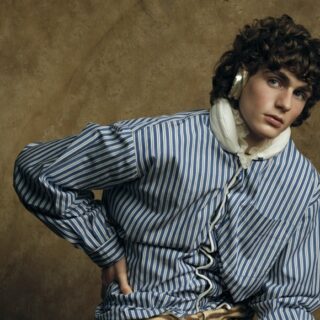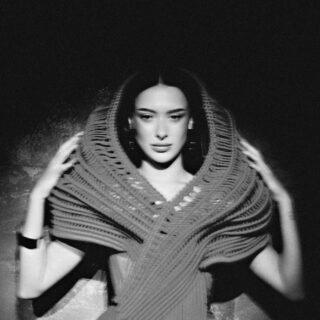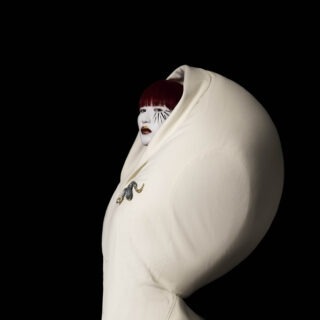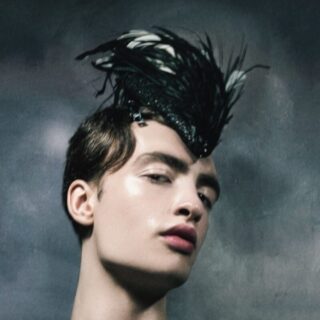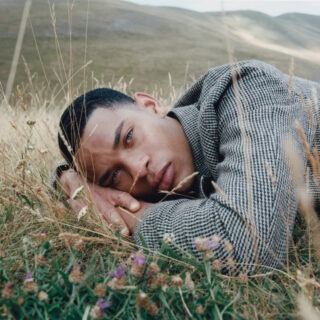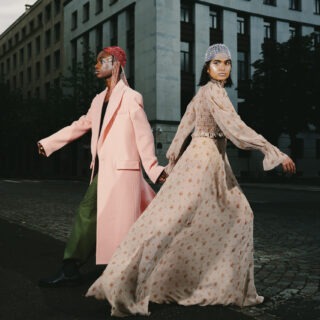photography. Julia Comita
fashion. Nathan Sweet
issue 7 – on the edge
Kiara Marshall has been sharing her body with technology for over 20 years.
She experienced life as an able-bodied person before losing part of her right leg and becoming an amputee at a young age. As a very active person, going through life without a prosthetic was never an option for her. Post amputation, she spent a year healing her body before she introduced a clunky prosthetic known as a “total knee.” This terribly uncomfortable leg prosthetic was strapped to her body with a belt that has left scars on her body to this day.
In the two decades following, Kiara has undergone several prosthetic technology advances. After the “total knee,” she graduated to a hydraulic prosthetic leg. This leg uses hydraulic fluid to control the movement of the knee joint, a function designed to mimic the natural movement of a real leg. Currently, she wears a microprocessor leg, an electronic device that simulates her natural gate and allows her to engage in intense physical activity, such as being a backpacking guide, something she did for several years in her twenties.
When asked about disability representation in fashion and what got her into modeling, Kiara reflects on all the negative stereotypes there are around disability and how media representation fuels common misconceptions about what it means to have a disability. Historically, the fashion and beauty industries have been slow to incorporate inclusive casting of all different bodies. “I think that in our society, we really value symmetry and perfection, and our beauty standards are just very narrow,” she says with consideration. In reality, a body that’s lived through amputation is something that should be championed and celebrated. “[Bodies] are not perfect, scars happen, they’re a sign that you’ve lived through whatever was trying to kill you,” she adds.
Kiara made the trip to New York in January of 2024 to participate in the Synthesis project, a photo shoot that celebrates the merging of humans and technology as highlighted through prosthetics. At a time when “inclusivity” can manifest as performative activism, merely showcasing individuals from various historically underrepresented backgrounds as a way of box-ticking representation, it was vital for Kiara to participate in an authentic project where she felt safe and seen. She was also thrilled to model alongside London-based legend Kelly Knox, a limb-different model with over a decade of experience in the fashion industry.
Kelly grew up in the U.K. and was born without her left arm. She never felt anything was wrong with her because she was missing a limb. From the time she was a baby, Kelly was pressured into wearing a prosthetic. In the nineties in the U.K., all that was available was a stiff plastic arm with no functionality. Imagine the arm of a baby doll. This arm was so unbearable that when Kelly was little, she recalls a time when she ripped it off and threw it out of her stroller in public, causing a disturbance.
“When I wore [the prosthetic arm], it made me feel disabled. Without it, I could do absolutely anything I wanted to do,” Kelly says. When she began modeling, she was told, “If you wear a prosthetic, you’ll get more work.” Conform, and you’ll receive validation from society, was the underlying message. It wasn’t until approximately 2017 that Kelly felt inspired to wear a prosthetic designed by artist and engineer Sophie de Oliveira Barata, founder of The Alternative Limb Project.
Sophie has designed custom limbs for celebrities, paralympic athletes, and video game companies and has been featured in dozens of publications. Each prosthetic limb that Sophie designs is a one-of-a-kind work of art. Fascinated by “body image, modification, evolution, and transhumanism,” Sophie’s limbs promote a future-forward vision of what prosthetic limbs could be like.
This approach to embracing prosthetics and body diversity as empowering led Kelly and Sophie into a multi-year partnership. This partnership resulted in designing and fabricating three unique prosthetic arms, including the “Synchronized” arm that Kelly wore for the Synthesis photo shoot. This prosthetic connects and responds to own Kelly’s heartbeat! For Kelly, who has gone her whole life without needing a prosthetic, she only chooses to wear one if it emboldens her aesthetically. Aesthetics have been historically deprioritized over functionality when it comes to prosthetics, and for good reason. As Kelly experienced growing up, it was better to have no prosthetic than a useless one. But times are changing, and both Kiara and Kelly share a desire to use prosthetic limbs as a form of personal expression, a further extension of who they are instead of merely an object connected to their bodies.
According to Hildur Einarsdóttir, executive vice president of research and development at prosthetic tech giant Össur, aesthetics are critical, and the industry of prosthetic tech is finally “respecting the complex journey our patients go on and understanding that prosthetic care is more than [just] a mechanical problem to solve.” Össur, initially founded in 1971 by amputee Össur Kristinsson, envisions a world in which individuals living with chronic mobility conditions are free to pursue their dreams without the obstacle of physical impairment. Einarsdóttir admits that on the journey of prosthetic advancement, where topics like physical comfort, device longevity, and financial accessibility are still a concern, a significant challenge is “pairing aesthetics with technology.”
Given that a prosthetic limb replaces something as intimate as a body part, one could understand why aesthetics should not be undervalued for the wearer. Kiara notes about her own prosthetic leg, “[It’s] an extension of me, it’s my body part; I don’t really see it as only a device.” For those trying to blend into a society skewed towards catering to the able-bodied or hoping to recreate the experience of having a lost limb, it’s understandable why creating prosthetics that look and feel like natural body parts is of great importance. For others, including Kiara and Kelly, being limb-different is an empowering difference that makes them unique to most other individuals. Kelly says, “Wearing something like [a prosthetic arm] shouldn’t be about making you blend in,” but rather about helping one to stand out against the crowd. Both women expressed that wearing a fashion or art-forward prosthetic makes them feel “like a piece of art.”
Synthesis embodies technology as a form of personal expression and wearable art while celebrating limb-different talent and those with prosthetics. Approaching the possibilities offered by the evolution of prosthetics and technology with excitement and curiosity needs to become the norm. We are entering an era where a prosthetic can provide an opportunity for self-expression in the same way that wearing a fantastic outfit can impact how one presents themselves to the world. Model Kelly Knox hopes that the audience for Synthesis will “change [their] perceptions and what they feel that disability is or what disabled people should look like.”
words. Julia Comita
photography. Julia Comita
fashion. Nathan Sweet
creative direction. Alex Palomo
models. Kiara Marshall @ We Speak
Kelly Knox @ Base Models
hair. Cassie Carey
make up. Kento Utsubo for MAC Cosmetics
nails. Clawed by LaCreme
production. Nem Fisher
movement director. Zoe Rappaport
photography assistants. Brandon Abreu + Angela Cholmondeley
grip. Daniel Walsh
fashion assistants. Corin Christian + Samantha Siciliano
make up assistant. Robin Stright
production assistants. Elinor Kelly, Elizabeth Phelps,
May Ruzicka + Marko Medic
vfx studio. Volvox Labs
vfx creative director. Kamil Nawratil
vfx art director. Pasakorn Nontananandh
robot director. Zyia Zhang
vfx producer. Javier Cruz
retoucher. Cosmic Pixels
location. Volvox Labs, New York City
words. Julia Comita
© Schön! Switzerland. All rights reserved.

